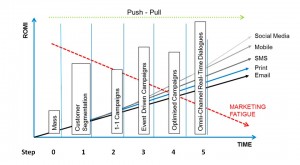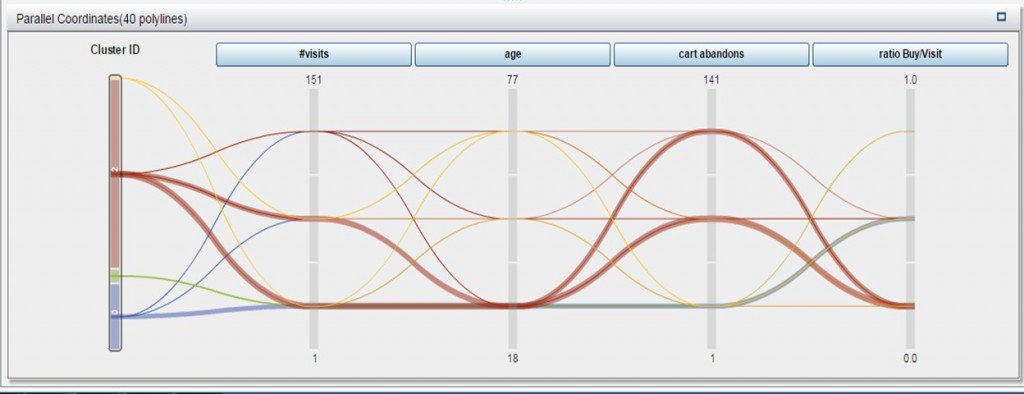As a customer intelligence adviser, my work exposes me to a wide range of organizations with various marketing challenges and available resources. Over time, some common themes have emerged, one of which is omni-channel marketing as a business imperative. Changes in the ways customers engage with brands across an explosion of channels have prompted the need for organizations to engage in omni-channel marketing.
Best practices are starting to emerge for mastering omni-channel marketing, and I've seen that they seem to fall into a five-step pattern, which I will lay out for you in this short blog series titled, Five steps to omni-channel marketing.

During recent customer visits, I have noticed assumptions being made about making the transition from mass marketing to omni-channel marketing - at times expecting it to take just a month or two. Most of the time customers are surprised when I explain that there is a maturity curve you need to go through. In today’s blog post I will try to explain my vision on moving from mass marketing to fully omni-channel marketing.
We have detected 6 maturity levels when it comes to omni-channel marketing. Every level requires a more advanced step of analytics. So the evolution from one level to the next is directly linked to the maturity of the insights you can create. For example event-driven campaigns on churn may prove much less effective if you don’t score the people that have a high probability to churn.
The goal of omni-channel marketing is to deliver the right message, at the right time, through the right channel, taking into account your commercial strategy. The inclusion of your commercial objectives is important because achieving customer centricity is only meaningful when it supports your business goals. So on that basis, let's examine the first step in this process.
Step 1: From mass marketing to customer segmentation
Mass marketing means that you are sending the same message/product to all of your customers. Imagine that, as a retailer, you hold a campaign for dog food. You would send all your contacts an email for dog food, ignoring the fact that maybe 50 % of your customers don't have pets, and dog owners are just a portion of that sub-set. Therefore your dog food sale is of no interest to most of your customers, and in the "best" case your message is merely deleted or discarded by most of its recipients. What about the more likely scenario of irritating most of your customers? What would happen over time if you did that repeatedly? Your dog food message is a #fail by any measure.
Customer segmentation is a marketing approach that's a long-established practice that I put forth as the first step, and which forms the basis for the next 4 steps. This involves dividing all your customers into subsets with a common interest. This means that when you have two segments and you would send them the same product or communication, they would respond in a different way. Let’s take our dog food example. Based on rules we could make a segment of people who bought dog food in the last 6 months and people who have never bought dog food. You obviously have a higher chance that people who bought dog food in the past will react positively compared to people who never bought dog food before. Sending the same message to the people who haven’t bought dog food results in an irrelevant message for that specific segment and a loss in marketing spend as you have no responders.
Very few business scenarios are that simple, so let's consider a more complicated rule-based approach known as RFM segmentation. In this approach, you score the customer behavior based on Recency (How row recent was the customer’s last purchase), Frequency (how many times did he/she visit our company), and Monetary (how much has a customer spent). The idea here is that this allows you to identify your most loyal and valuable customers, which can be done as my colleague Chris Hemedinger spelled out in a wonderful blog post, Customer Segmentation using RFM in SAS Enterprise Guide.
The best form of segmentation is the analytics-driven approach which involves a descriptive analytical technique, such as a cluster analysis. The benefit of using analytical techniques is that you can use multiple variables to detect which segments you can find in your data. Often an RFM score is part of your cluster analysis.
Until a few years ago, using these techniques was often a bridge too far for marketers. But the rise of data visualization tools, making analytics accessible to non-technical people, has changed that. The picture below shows an example of a cluster analysis in SAS® Visual Statistics:
The graph shows 4 segments indicated by 4 colored lines. The lines go up and down based on the value they have for a specific variable. One example of what is revealed in this view is that the red line (segment 2) has people with a very low amount of visits, are rather young and have a high cart abandonment rate. This could indicate that this is for example a price seeker segment that comes to our website to look for the best deals. That combination of factors may point to a low-value segment you don't want to emphasize, or it may spell an opportunity to reach a market you could appeal to by making some changes. This visual based on a simple segmentation exercise could spark that kind of strategic discussion, and take you one step closer to mastering omni-channel marketing.
Have I gotten your attention? Stay tuned for the next step, when we look at going from customer segmentation to 1-to-1 campaigns, or check out the whole series when it's complete at this tag: Five Steps Omni-Channel. And thank you for following!



6 Comments
Cluster Analysis visual references an image on the sww rather than www - http://sww.sas.com/blogs/wp/digitizingemea/files/2015/06/Segmentation-visual-stat-e1434615221766.jpg
Hard to interpret the graph as per the second last paragraph ;-)
Thanks,
Michelle
Thanks for updating the image. I understand the paragraph now :-)
Kind Regards,
Michelle
Thanks, Michelle! And sorry about the photo mix-up. This whole post by Steven is wonderful in its practicality. I am looking forward to the rest of this series!
Cheers!
JB
Thanks Michelle to let us now that the picture wasn't working! Hope you enjoy reading the post!
Pingback: From mass to realtime omni-channel marketing in 5 steps
Pingback: Five steps to omni-channel marketing - Step 3